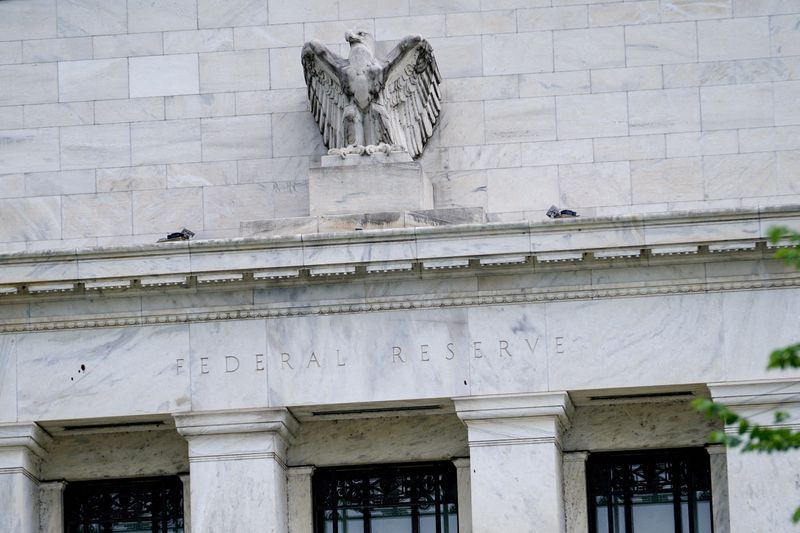By Jamie McGeever
ORLANDO, Florida (Reuters) -Last month Federal Reserve Chair Jerome Powell and his colleagues were lauded for starting their policy easing cycle with a half percentage-point rate cut that many said would help secure the U.S. economy's much-vaunted 'soft landing'.
But that cut was followed by a hot September jobs report, featuring the third-largest jump in payrolls ever after the initial cut in a Fed hiking cycle. Since then, Treasury bond yields, inflation expectations and the so-called 'term premium' have all spiked.
The Fed is now coming under increasing fire for potentially committing the ultimate central banking sin: a policy error. But history suggests this charge is far too premature.
OVERREACTION?
Since the jumbo rate cut on Sept. 18, there has been a sharp rise in long-dated bond yields, inflation expectations and the term premium - the compensation investors demand for buying longer-dated U.S. government bonds rather than rolling over shorter term ones.
This likely reflects investors' worries about fiscal profligacy as much as overly dovish monetary policy, given that former President Donald Trump has appeared to regain ground in the presidential election race while touting a host of potentially budget-busting plans. Still, the market moves all began around the date of the Fed's rate cut.
And they're significant.
Analysts at Bespoke Investment Group note that of the 35 times the Fed has cut rates since 1994, this is the third-largest rise in the 10-year yield, behind only those seen in November 2001 and June 2008.
Meanwhile, the breakeven inflation rate on 10-year inflation-protected Treasury bonds, or 'TIPS', has leaped 25 bps to 2.35%, moving farther away from the Fed's 2% inflation target. Are these outliers? Certainly. Evidence of a policy error? Not so fast.
DOOMSTERS
When attempting to determine if any particular decision is a 'policy error', it's important to acknowledge that there is significant disagreement about what the term actually means.
That's partly because the Fed has perpetual critics – "doomsters", according to TS Lombard's Dario Perkins - who think monetary policy itself is essentially one big, permanent mistake.
Was the Fed's decision not to quickly raise rates from zero after the pandemic a mistake, even though inflation was largely being driven by gummed-up global supply chains? Many people say it was, citing the near double-digit inflation that followed as evidence.
On the other hand, can the Fed be blamed for not foreseeing Russia's invasion of Ukraine and the subsequent surge in global commodity and energy prices? And let's not forget, that supply-driven inflation has, by and large, proven to be transitory.
Questions around such decisions or non-decisions typically center on timing and degree rather than direction. If a central bank is a little too early or late in moving, or if it delivers 50 bps of easing in one meeting as opposed to 25 bps over two, the overall economic impact is likely to be minimal and short-lived. So are these really errors?
BACKTRACKING
Still, there is one definition of a 'policy error' that most central bank watchers would agree on: a decision that is reversed quickly. And there are a few recent examples from Europe that meet this criteria.
The European Central Bank's rate hike in July 2008, right as the global financial crisis was reaching its zenith, and those in April and July 2011, in the midst of the euro zone debt crisis, stand out.
They defied consensus thinking at the time, as most observers were convinced the euro zone economy needed looser monetary policy. The July 2008 and 2011 moves were reversed within a few months.
Even more surprising, Sweden's Riksbank raised its policy rate in September 2008, just days before Lehman Brothers collapsed. The rate was down to virtually zero within 10 months.
Importantly, these policy reversals coincided with real world downturns. While it's impossible to know how much damage the erroneous decisions themselves caused, it's fair to say they didn't help.
PATIENCE
So what does this history lesson teach us about the Fed's current situation? That we have to wait.
With the benefit of hindsight, the Fed may determine that it should have opted to cut rates by 25 bps in September rather than 50, and it may even pause next month as a result. But its direction of travel is not in doubt.
Ultimately, it will be impossible to properly assess the Fed's actions until after the presidential election on Nov. 5, when the central bank will have a better sense of which tax, spending, labor market and immigration policies are likely to be in place over the next four years.

So maybe the Fed will have to keep monetary policy slightly tighter than it had planned to counter lax fiscal policy or vice versa. But reversing course all together, rendering September's rate cut a true policy error? That would be a shock.
(The opinions expressed here are those of the author, a columnist for Reuters.)
(By Jamie McGeeverEditing by Christina Fincher)